The global yellow petroleum jelly market is estimated to grow from USD 1,431 million in 2025 to approximately USD 2,421.3 million by 2035, recording an absolute increase of USD 990.3 million over the forecast period. This translates into a total growth of 69.2%, with the market forecast to expand at a compound annual growth rate (CAGR) of 5.4% between 2025 and 2035. The overall market size is expected to grow by nearly 1.69X during the same period, supported by increasing pharmaceutical applications, growing cosmetic industry demand, and rising adoption of petroleum jelly in industrial lubricant applications across global markets.
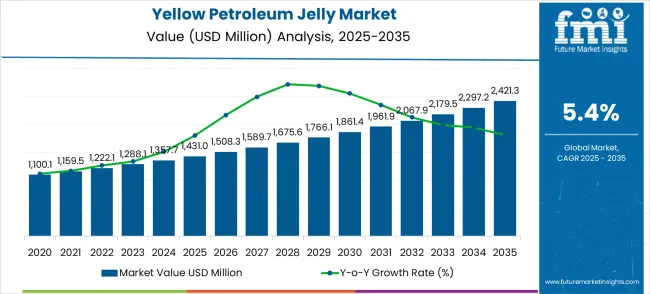
Between 2025 and 2030, the yellow petroleum jelly market is projected to expand from USD 1,431 million to USD 1,861.4 million, resulting in a value increase of USD 430.4 million, which represents 43.5% of the total forecast growth for the decade. This phase of growth will be shaped by increasing pharmaceutical industry expansion, growing cosmetic product development, and rising adoption of petroleum jelly in personal care applications. Manufacturers are investing in high-quality, pharmaceutical-grade petroleum jelly production to meet stringent regulatory requirements and growing healthcare sector demand.
| Metric | Value |
|---|---|
| Market Value (2025) | USD 1,431 million |
| Market Forecast Value (2035) | USD 2,421.3 million |
| Forecast CAGR (2025-2035) | 5.4% |
The yellow petroleum jelly market holds a prominent position within the petroleum jelly market, accounting for approximately 20% of the share, as it is widely used in both personal care and industrial applications. In the personal care products market, it accounts for approximately 15%, reflecting its use in moisturizing creams and lip balms. The cosmetics ingredients market accounts for approximately a 10% share, driven by its inclusion in various skin care and beauty formulations. Within the healthcare products market, the market share is around 7%, as yellow petroleum jelly is often used in topical treatments and wound care products. In the lubricants market, it holds approximately 5%, primarily used as a low-cost lubricant in industrial applications.
Market expansion is being supported by the increasing pharmaceutical applications across global healthcare markets and the corresponding need for high-quality petroleum jelly products in drug formulations and medical applications. Modern pharmaceutical and cosmetic industries require versatile base materials with excellent barrier properties and skin compatibility, creating sustained demand for pharmaceutical-grade petroleum jelly. The superior moisturizing properties and chemical inertness of yellow petroleum jelly make it an essential ingredient in demanding healthcare applications where product safety and efficacy are critical.
The growing emphasis on personal care and skincare products is driving demand for high-quality petroleum jelly from certified manufacturers with proven track records of pharmaceutical-grade production capabilities. Cosmetic and pharmaceutical companies are increasingly investing in premium petroleum jelly products that offer superior purity and consistent quality while meeting stringent regulatory requirements for healthcare applications. Industry standards and regulatory certifications are establishing quality benchmarks that favor precision-refined petroleum jelly with verified purity levels and comprehensive safety documentation.
The healthcare industry's focus on wound care and dermatological applications is creating substantial demand for reliable petroleum jelly products capable of providing effective skin protection and healing support. The industrial sector continues to drive innovation in lubricant applications while maintaining cost-effectiveness, leading to development of specialized petroleum jelly formulations with enhanced performance characteristics and optimized viscosity properties for diverse industrial applications.
The market is segmented by grade type, application, and region. By grade type, the market is divided into pharma grade, cosmetic grade, industrial grade, and other configurations. Based on application, the market is categorized into pharmaceutical, cosmetic, industrial lubricant, and other applications. Regionally, the market is divided into North America, Europe, East Asia, South Asia & Pacific, Latin America, and Middle East & Africa.
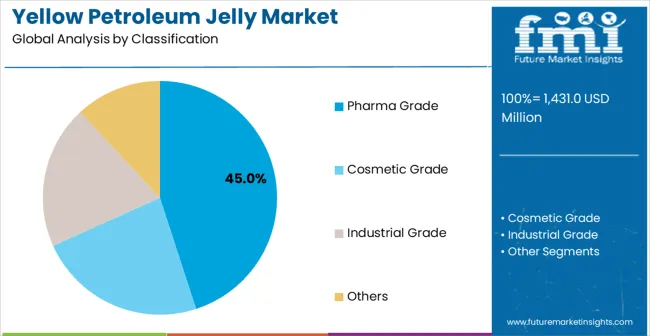
Pharma grade configurations are projected to account for 45% of the yellow petroleum jelly market in 2025. This leading share is supported by the increasing demand for pharmaceutical-grade materials in healthcare applications and growing quality requirements in drug formulation and medical device manufacturing. Pharma grade petroleum jelly provides superior purity and safety characteristics, making it the preferred choice for pharmaceutical formulations, medical applications, and healthcare product manufacturing. The segment benefits from advanced refining technologies that have achieved exceptional purity levels while maintaining cost-effectiveness for pharmaceutical applications.
Modern pharma grade petroleum jelly incorporates sophisticated purification processes and enhanced quality control techniques that maximize product purity while ensuring consistent pharmaceutical compliance across production batches. These innovations have significantly improved pharmaceutical application performance while reducing impurity-related formulation complications that can affect drug efficacy and patient safety. The pharmaceutical industry particularly drives demand for pharma grade solutions, as these applications require absolute purity and superior quality characteristics to meet FDA and international pharmaceutical regulatory standards.
Additionally, the medical device and wound care markets increasingly adopt pharma grade petroleum jelly to ensure consistent product safety and enhance therapeutic effectiveness in critical healthcare applications. The growing emphasis on pharmaceutical quality creates opportunities for specialized ultra-high purity petroleum jelly formulations designed for advanced pharmaceutical and medical applications.
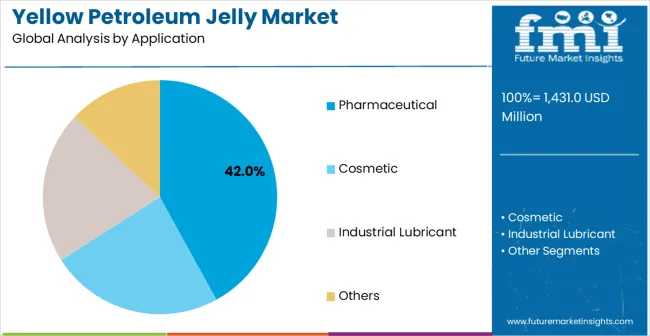
Pharmaceutical applications are expected to represent 42% of yellow petroleum jelly demand in 2025. This dominant share reflects the critical role of petroleum jelly in pharmaceutical formulations and growing demand for versatile base materials in drug development and healthcare products. Pharmaceutical manufacturers require high-quality petroleum jelly capable of providing consistent performance while maintaining strict quality control and regulatory compliance standards. The segment benefits from continuous innovation in pharmaceutical science that utilizes petroleum jelly's unique properties for enhanced drug delivery and topical applications.
The global pharmaceutical industry drives significant demand for pharmaceutical-grade petroleum jelly that provides exceptional purity and consistent performance characteristics for drug formulation and medical applications. These applications require petroleum jelly with superior quality specifications and comprehensive pharmaceutical documentation to ensure regulatory compliance and patient safety. The segment benefits from growing pharmaceutical industry investment in topical drug development and increasing demand for dermatological and wound care applications.
The cosmetic and personal care sectors contribute substantially to market growth as companies incorporate petroleum jelly into skincare products and cosmetic formulations. The growing adoption of natural and safe ingredients creates opportunities for specialized petroleum jelly applications designed for premium cosmetic and personal care products. Additionally, the trend toward multifunctional ingredients drives demand for versatile petroleum jelly, which enables diverse formulation applications and enhances product performance.
The yellow petroleum jelly market is advancing steadily due to increasing healthcare applications and growing recognition of petroleum jelly's versatility across pharmaceutical and cosmetic applications. However, the market faces challenges including stringent regulatory compliance requirements, need for consistent quality standards, and varying purity specifications across different industrial applications. Quality certifications and pharmaceutical standards continue to influence production practices and market development patterns.
The growing adoption of sophisticated refining processes and enhanced quality control systems is enabling significant purity improvements while maintaining pharmaceutical-grade compliance standards in petroleum jelly production. Advanced purification techniques and pharmaceutical quality assurance provide better product consistency and superior regulatory compliance documentation, enabling reliable pharmaceutical applications and enhanced customer confidence. These technologies are particularly valuable for pharmaceutical applications that require maximum purity and comprehensive quality verification.
Modern petroleum jelly manufacturers are developing specialized formulations tailored to specific industry requirements, including ultra-high purity materials for pharmaceutical applications, cosmetic-grade products with enhanced skin compatibility, and industrial formulations with optimized performance characteristics. Advanced refining techniques enable precise optimization of product properties for targeted applications while maintaining manufacturing scalability and regulatory compliance.
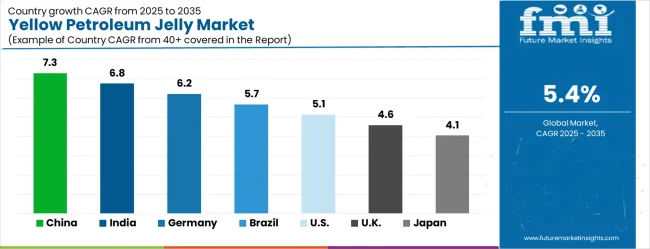
| Country | CAGR (2025-2035) |
|---|---|
| China | 7.3% |
| India | 6.8% |
| Germany | 6.2% |
| Brazil | 5.7% |
| United States | 5.1% |
| United Kingdom | 4.6% |
| Japan | 4.1% |
The yellow petroleum jelly market is growing robustly, with China leading at a 7.3% CAGR through 2035, driven by expanding pharmaceutical manufacturing and growing cosmetic industry development. India follows at 6.8%, supported by increasing healthcare infrastructure and rising personal care market expansion. Germany records strong growth at 6.2%, emphasizing pharmaceutical industry excellence and advanced cosmetic product development. Brazil grows solidly at 5.7%, benefiting from expanding healthcare sector and cosmetic industry growth. The United States shows steady growth at 5.1%, focusing on pharmaceutical innovation and premium cosmetic applications. The United Kingdom maintains expansion at 4.6%, supported by healthcare industry advancement. Japan demonstrates growth at 4.1%, emphasizing quality excellence and precision pharmaceutical applications.
The report covers an in-depth analysis of 40+ countries, the top-performing countries are highlighted below.
The yellow petroleum jelly market in China is projected to exhibit the highest growth rate with a CAGR of 7.3% through 2035, driven by the country's expanding pharmaceutical manufacturing capabilities and rapidly growing cosmetic industry development. The extensive pharmaceutical production infrastructure and increasing investment in healthcare product manufacturing are creating substantial opportunities for high-quality petroleum jelly demand. Major pharmaceutical and cosmetic companies are establishing comprehensive supply chains to support both domestic market requirements and international export opportunities while meeting global quality standards.
Pharmaceutical manufacturing expansion and cosmetic industry development are supporting widespread adoption of pharmaceutical-grade petroleum jelly across commercial production operations, driving demand for high-purity products and comprehensive quality assurance systems. Domestic market growth and export manufacturing development are creating significant opportunities for Chinese petroleum jelly producers in global pharmaceutical and cosmetic supply chains requiring consistent quality and competitive pricing.
The yellow petroleum jelly market in India is expanding at a CAGR of 6.8%, supported by the country's increasing healthcare infrastructure development and rising personal care market expansion under economic development initiatives. The growing pharmaceutical industry capabilities and increasing consumer spending on personal care products are driving substantial petroleum jelly demand potential. Manufacturing facilities are leveraging cost advantages while adopting international quality standards to meet domestic healthcare requirements and export market opportunities.
Healthcare infrastructure growth and personal care market expansion are creating opportunities for high-quality petroleum jelly integration across diverse healthcare and cosmetic categories requiring pharmaceutical-grade materials and reliable performance systems. Domestic market development and international collaboration programs are driving investments in advanced petroleum jelly production technologies throughout major pharmaceutical and cosmetic manufacturing regions.
The yellow petroleum jelly market in Germany is projected to grow at a CAGR of 6.2%, supported by the country's leadership in pharmaceutical industry development and advanced cosmetic product technology applications. German pharmaceutical and cosmetic companies are implementing sophisticated petroleum jelly applications that meet stringent quality standards and regulatory requirements. The market is characterized by focus on innovation, advanced purification technologies, and compliance with comprehensive pharmaceutical and cosmetic safety regulations.
Pharmaceutical industry investments are prioritizing advanced petroleum jelly processing technologies that demonstrate superior purity levels and regulatory compliance while meeting German pharmaceutical quality and safety standards for healthcare applications. Innovation programs and pharmaceutical technology development initiatives are driving adoption of precision-refined petroleum jelly systems that support optimal pharmaceutical performance and enhanced product safety.
The yellow petroleum jelly market in Brazil is growing at a CAGR of 5.7%, driven by expanding healthcare sector capabilities and growing cosmetic industry infrastructure across pharmaceutical and personal care markets. The growing investment in healthcare infrastructure and increasing focus on pharmaceutical manufacturing development are creating opportunities for petroleum jelly demand growth. Healthcare and cosmetic facilities are adopting quality products to support growing domestic demand and regional market requirements while maintaining cost competitiveness.
Healthcare sector development and cosmetic industry expansion are facilitating adoption of effective petroleum jelly systems capable of meeting diverse healthcare requirements and pharmaceutical specifications across medical and personal care applications. Regional healthcare capability enhancement and pharmaceutical industry development are creating demand for standardized petroleum jelly products that meet healthcare industry specifications and quality requirements.
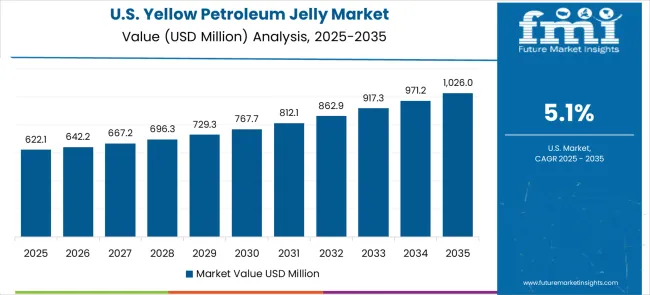
The yellow petroleum jelly market in the United States is expanding at a CAGR of 5.1%, driven by the country's pharmaceutical innovation leadership and increasing emphasis on premium cosmetic and healthcare applications. The sophisticated healthcare industry ecosystem and focus on advanced pharmaceutical development create consistent demand for high-quality petroleum jelly solutions. The market benefits from pharmaceutical research expansion and cosmetic innovation across multiple healthcare and personal care segments.
Pharmaceutical innovation programs and premium application development initiatives are driving adoption of advanced petroleum jelly products that offer superior purity characteristics and regulatory compliance for pharmaceutical applications. Research and development investments and healthcare technology advancement are supporting demand for specialized petroleum jelly formulations that meet stringent pharmaceutical quality requirements and innovation standards.
The yellow petroleum jelly market in the United Kingdom is projected to grow at a CAGR of 4.6%, supported by ongoing healthcare industry advancement and increasing emphasis on product quality in pharmaceutical and cosmetic applications. Healthcare and cosmetic companies are investing in high-quality petroleum jelly solutions that provide consistent performance characteristics and meet regulatory compliance requirements for healthcare applications. The market is characterized by focus on pharmaceutical quality, regulatory compliance, and advanced healthcare product development.
Healthcare industry advancement and product quality programs are supporting adoption of validated petroleum jelly solutions that meet contemporary pharmaceutical and cosmetic standards for healthcare applications. Quality enhancement initiatives and healthcare compliance programs are creating demand for specialized petroleum jelly applications that provide superior quality consistency and pharmaceutical-grade verification.
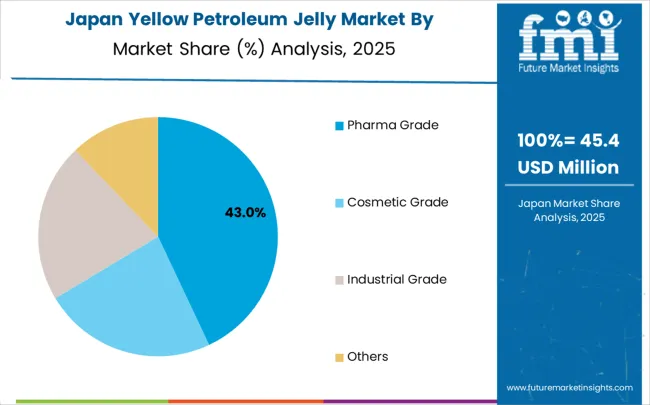
The yellow petroleum jelly market in Japan is expanding at a CAGR of 4.1%, driven by the country's emphasis on quality excellence and precision pharmaceutical and cosmetic application development. Japanese pharmaceutical and cosmetic companies are developing advanced petroleum jelly applications that incorporate precision refining and quality optimization principles. The market benefits from focus on product precision, quality reliability, and continuous improvement in pharmaceutical and cosmetic formulation techniques.
Quality excellence programs and precision application initiatives are driving advancement of premium petroleum jelly applications that demonstrate superior quality characteristics and formulation reliability. Pharmaceutical and cosmetic excellence programs are supporting adoption of precision-refined petroleum jelly solutions that optimize product performance and ensure consistent quality in demanding pharmaceutical and cosmetic applications.
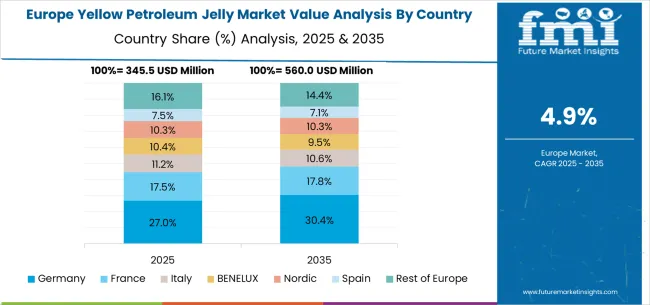
The yellow petroleum jelly market in Europe is projected to grow from USD 394.2 million in 2025 to USD 612.4 million by 2035, registering a CAGR of 4.5% over the forecast period. Germany is expected to maintain its leadership with a 24.8% share in 2025, supported by its advanced pharmaceutical industry and cosmetic product excellence. The United Kingdom follows with 19.2% market share, driven by healthcare industry advancement and pharmaceutical quality development. France holds 17.6% of the European market, benefiting from cosmetic industry expansion and pharmaceutical manufacturing development. Italy and Spain collectively represent 21.7% of regional demand, with growing focus on pharmaceutical applications and cosmetic product development. The Rest of Europe region accounts for 16.7% of the market, supported by healthcare development in Eastern European countries and Nordic pharmaceutical advancement.
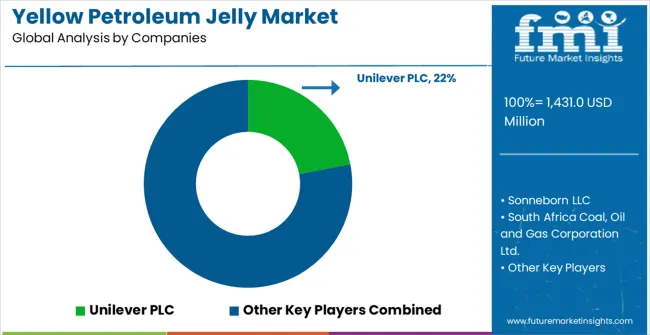
The yellow petroleum jelly market is defined by competition among established petroleum refining companies, specialized pharmaceutical ingredient manufacturers, and cosmetic raw material suppliers. Companies are investing in advanced refining technologies, pharmaceutical-grade production systems, quality excellence programs, and regulatory compliance capabilities to deliver reliable, pure, and cost-effective petroleum jelly solutions. Strategic partnerships, technological advancement, and geographic expansion are central to strengthening product portfolios and market presence.
Unilever PLC, operating globally, offers comprehensive personal care and pharmaceutical ingredient solutions with focus on quality excellence, regulatory compliance, and consumer safety across healthcare and cosmetic applications. Sonneborn LLC, established petroleum specialty manufacturer, provides advanced petroleum jelly products with emphasis on pharmaceutical-grade quality and industrial application optimization. South Africa Coal, Oil and Gas Corporation Ltd. delivers specialized petroleum refining with focus on quality products and regional market leadership.
Navid Noor Co. offers comprehensive petroleum products with standardized procedures and regional manufacturing support. Kerax Limited provides advanced petroleum specialty products with emphasis on pharmaceutical applications and quality excellence. Spectrum Chemical Mfg. Corp. delivers specialized chemical and pharmaceutical ingredients with focus on quality assurance and regulatory compliance. Taurus Petroleums Pvt. Ltd. offers comprehensive petroleum refining with regional manufacturing and quality capabilities.
Qingdao Fengchen technology and Trade Co.,Ltd, Unicorn Petroleum Industries Pvt. Ltd., and PT. Kirana Mitraabadi offer specialized yellow petroleum jelly expertise, regional production capabilities, and technical support across petroleum refining and pharmaceutical ingredient networks.
The yellow petroleum jelly market underpins pharmaceutical formulation excellence, cosmetic product development, healthcare application advancement, and industrial lubricant optimization. With growing pharmaceutical applications, cosmetic industry expansion, and quality compliance requirements, the sector faces pressure to balance product purity, regulatory compliance, and cost-effectiveness. Coordinated contributions from governments, industry bodies, OEMs/technology integrators, suppliers, and investors will accelerate the transition toward high-purity, pharmaceutical-grade, and application-optimized yellow petroleum jelly solutions.
Quality Investment: Channel capital toward pharmaceutical-grade production facilities, advanced quality control systems, and regulatory compliance technologies for enhanced market positioning and healthcare industry access.
| Item | Value |
|---|---|
| Quantitative Units | USD 1,431 million |
| Grade Type | Pharma Grade, Cosmetic Grade, Industrial Grade, Others |
| Application | Pharmaceutical, Cosmetic, Industrial Lubricant, Others |
| Regions Covered | North America, Europe, East Asia, South Asia & Pacific, Latin America, Middle East & Africa |
| Country Covered | United States, Germany, India, China, United Kingdom, Japan, Brazil, and other 40+ countries |
| Key Companies Profiled | Unilever PLC, Sonneborn LLC, South Africa Coal, Oil and Gas Corporation Ltd., Navid Noor Co., Kerax Limited, Spectrum Chemical Mfg. Corp., Taurus Petroleums Pvt. Ltd., Qingdao Fengchen technology and Trade Co.,Ltd, Unicorn Petroleum Industries Pvt. Ltd., PT. Kirana Mitraabadi |
The global yellow petroleum jelly market is estimated to be valued at USD 1,431.0 million in 2025.
The market size for the yellow petroleum jelly market is projected to reach USD 2,421.3 million by 2035.
The yellow petroleum jelly market is expected to grow at a 5.4% CAGR between 2025 and 2035.
The key product types in yellow petroleum jelly market are pharma grade, cosmetic grade, industrial grade and others.
In terms of application, pharmaceutical segment to command 42.0% share in the yellow petroleum jelly market in 2025.






Our Research Products

The "Full Research Suite" delivers actionable market intel, deep dives on markets or technologies, so clients act faster, cut risk, and unlock growth.

The Leaderboard benchmarks and ranks top vendors, classifying them as Established Leaders, Leading Challengers, or Disruptors & Challengers.

Locates where complements amplify value and substitutes erode it, forecasting net impact by horizon

We deliver granular, decision-grade intel: market sizing, 5-year forecasts, pricing, adoption, usage, revenue, and operational KPIs—plus competitor tracking, regulation, and value chains—across 60 countries broadly.

Spot the shifts before they hit your P&L. We track inflection points, adoption curves, pricing moves, and ecosystem plays to show where demand is heading, why it is changing, and what to do next across high-growth markets and disruptive tech

Real-time reads of user behavior. We track shifting priorities, perceptions of today’s and next-gen services, and provider experience, then pace how fast tech moves from trial to adoption, blending buyer, consumer, and channel inputs with social signals (#WhySwitch, #UX).

Partner with our analyst team to build a custom report designed around your business priorities. From analysing market trends to assessing competitors or crafting bespoke datasets, we tailor insights to your needs.
Supplier Intelligence
Discovery & Profiling
Capacity & Footprint
Performance & Risk
Compliance & Governance
Commercial Readiness
Who Supplies Whom
Scorecards & Shortlists
Playbooks & Docs
Category Intelligence
Definition & Scope
Demand & Use Cases
Cost Drivers
Market Structure
Supply Chain Map
Trade & Policy
Operating Norms
Deliverables
Buyer Intelligence
Account Basics
Spend & Scope
Procurement Model
Vendor Requirements
Terms & Policies
Entry Strategy
Pain Points & Triggers
Outputs
Pricing Analysis
Benchmarks
Trends
Should-Cost
Indexation
Landed Cost
Commercial Terms
Deliverables
Brand Analysis
Positioning & Value Prop
Share & Presence
Customer Evidence
Go-to-Market
Digital & Reputation
Compliance & Trust
KPIs & Gaps
Outputs
Full Research Suite comprises of:
Market outlook & trends analysis
Interviews & case studies
Strategic recommendations
Vendor profiles & capabilities analysis
5-year forecasts
8 regions and 60+ country-level data splits
Market segment data splits
12 months of continuous data updates
DELIVERED AS:
PDF EXCEL ONLINE
Yellow Fats Market Size and Share Forecast Outlook 2025 to 2035
Yellow Pea Protein Market Outlook - Growth, Demand & Forecast 2025 to 2035
Yellow Fever Treatment Market
Sunset Yellow FCF Market Size and Share Forecast Outlook 2025 to 2035
Bismuth Yellow Market Size and Share Forecast Outlook 2025 to 2035
Quinoline Yellow WS Market Size and Share Forecast Outlook 2025 to 2035
Carthamus Yellow Market
Petroleum Liquid Feedstock Market Size and Share Forecast Outlook 2025 to 2035
Petroleum And Fuel Dyes and Markers Market Size and Share Forecast Outlook 2025 to 2035
Petroleum Refinery Merchant Hydrogen Generation Market Size and Share Forecast Outlook 2025 to 2035
Petroleum Refinery Hydrogen Market Size and Share Forecast Outlook 2025 to 2035
Petroleum Refining Hydrogen Generation Market Size and Share Forecast Outlook 2025 to 2035
Petroleum Fuel Dyes and Markers Market 2025 to 2035
Petroleum Jelly Market Growth - Trends & Forecast 2025 to 2035
Captive Petroleum Refinery Hydrogen Generation Market Size and Share Forecast Outlook 2025 to 2035
Liquefied Petroleum Gas Storage Market Size and Share Forecast Outlook 2025 to 2035
Jelly Mist Market Size and Share Forecast Outlook 2025 to 2035
Royal Jelly Market Analysis by Type, Form, Application, and Region Forecast Through 2035
Low-Calorie Jelly Market Growth - Innovations & Market Expansion 2025 to 2035

Thank you!
You will receive an email from our Business Development Manager. Please be sure to check your SPAM/JUNK folder too.
Chat With
MaRIA